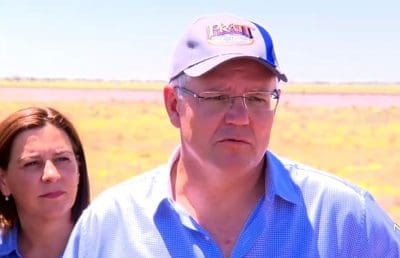PRIME Minister Scott Morrison has vowed to help rebuild Northwest Queensland’s cattle industry and support the recovery of battling farmers during a visit to the flood-ravaged region earlier today.
Mr Morrison saw first-hand the devastation that is unfolding across the region, during a tour across the Cloncurry and Julia Creek districts.

Prime Minister Scott Morrison at a media briefing in Julia Creek earlier today
The massive body of water that followed ten days of torrential rain earlier this month, which converged on key river systems between Cloncurry and Hughenden, covered an area of 13 million hectares or twice the size of Tasmania.
Estimates of stock losses continue to mount, some saying up to 500,000 cattle may now be lost. About 800 rural properties were affected in that region alone.
Mr Morrison flew into Cloncurry last night, meeting this morning with local cattle producers and community members and taking part in a defence force helicopter fodder drop.
“In a scene of a genuine national disaster, we’re seeing… the real resolve, the real heart and compassion of Australians, thinking of others first before themselves,” he told a media briefing a few hours ago.
“I’d ask all Australians to be mindful of the level of shock in all these communities. I know there are people all around the country who are wanting to help,” Mr Morrison said.
“The communities are working on the immediate response to the disaster that has occurred here. Right now the urgent need is to deal with the immediate response, which is why we have provided category D assistance to primary producers up to $25,000, ditching all the paperwork, and category C assistance to those small business that are eligible, and we are looking at the eligibility for that.”
“Where it’s needed, it’s going to happen. But the nature of our response is very much being guided by the local mayors right across northwest Queensland, and I want to commend them for their leadership. They are the ones in constant contact with their community.”
“There’s a long road ahead here. Of course we need to provide the immediate response, and that is occurring as we speak. We then must look to the future, which requires some key things to be done. The first is rebuilding infrastructure, which is linking the region and their economies,” Mr Morrison said.
“But it’s also about restocking, and the next five to ten years. This will again be one of the most prosperous regions in the country. It is the top of the supply-chain, in many respects, when it comes to our cattle industry,” he said.
“And we are going to rebuild the cattle industry here – that’s my message to the people of northwest Queensland. Mt government – working together with everyone else – will do everything to help people to do that.
“There’s issues of debt; there’s issues of stock losses; there’s issues of cash flow. We’re aware of all of these things, but the other thing we need to be keenly aware of is getting these recovery plans right.
“I’m also here not only offer some comfort… but to hear what the recovery and reconstruction plan is. We’re quite advanced in our thinking and planning in these areas. What we and others have done in the past 24 hours is to start to fashion some serious long-term plans.”
Mr Morrison said stakeholders did want to make decisions in the immediate wake of a disaster that they might later regret, so it was important to get those decisions right, by working closely together.
Generations of genetic progress lost
Mr Morrison described being with Julia Creek families this morning who had taken generations to build-up some of the finest herds of cattle in the world – let alone Australia.
“Generations of breeding, and to see that all washed away and lying in the mud was overwhelming. There’s a lot of healing that has to go on here.”
 Asked whether wider Australia understood the scale of the disaster that was unfolding in the region, he said he did not think they did.
Asked whether wider Australia understood the scale of the disaster that was unfolding in the region, he said he did not think they did.
“How could they? What they can’t understand, I suppose, is that it’s not just the immediate economic and natural impact, but it’s a livelihood and a way of life, and we must make sure that that does not get wiped out.”
“They want to stay, but they’re saying to me, can you help us stay? My answer to them is yes, I will.”
“But you can’t just go out put a bunch of new stock on these properties tomorrow morning. Fences have to be fixed, turkeys nests and roads repaired – there’s a tremendous amount of work to be done first.”
“On the property I was on today, they just can’t go and buy the same stock they had before. They built those stock up over generations, and they have to breed back up (to that level of quality).
“That will take many years. They may have other options in the meantime to run a cash operation, but to rebuild won’t happen overnight. For others, there will be opportunity for agistment from more drought affected areas. They’re the plans and details we have to work on.”
Mr Morrison said fodder drops would continue, especially further north into the gulf where floodwaters had headed, but other areas were now getting to the point of being over that immediate fodder demand.
Asked about the timeframe for longer 5-10 year plan recover plans, he said he was “not talking months.”
“You’ve got to keep the money churning in the local economies,” he said. “That’s one of the things we’ve learned from the drought. One of the things that’s been most successful through our drought program has been those million-dollar grants to local councils – a large investment of more than $100 million in total – which has helped keep money moving around the towns and communities.
“But there are no simple answers with disasters like this. It’s far more complex, and requires a much broader and more comprehensive response.”
Mr Morrison chose not to speculate about the overall extent of cattle losses in the region, but said he had spoken to producers near Julia Creek who had lost 50 to 100 percent of their herds.
“It’s the worst that’s ever been seen. There were bad floods here in the 1970s, but nothing like this. What really impacted this time was cattle in poor condition due to earlier drought, followed by combination of the floods, and cold windy conditions afterwards, causing cattle to die from exposure.”
